The Original Innovators
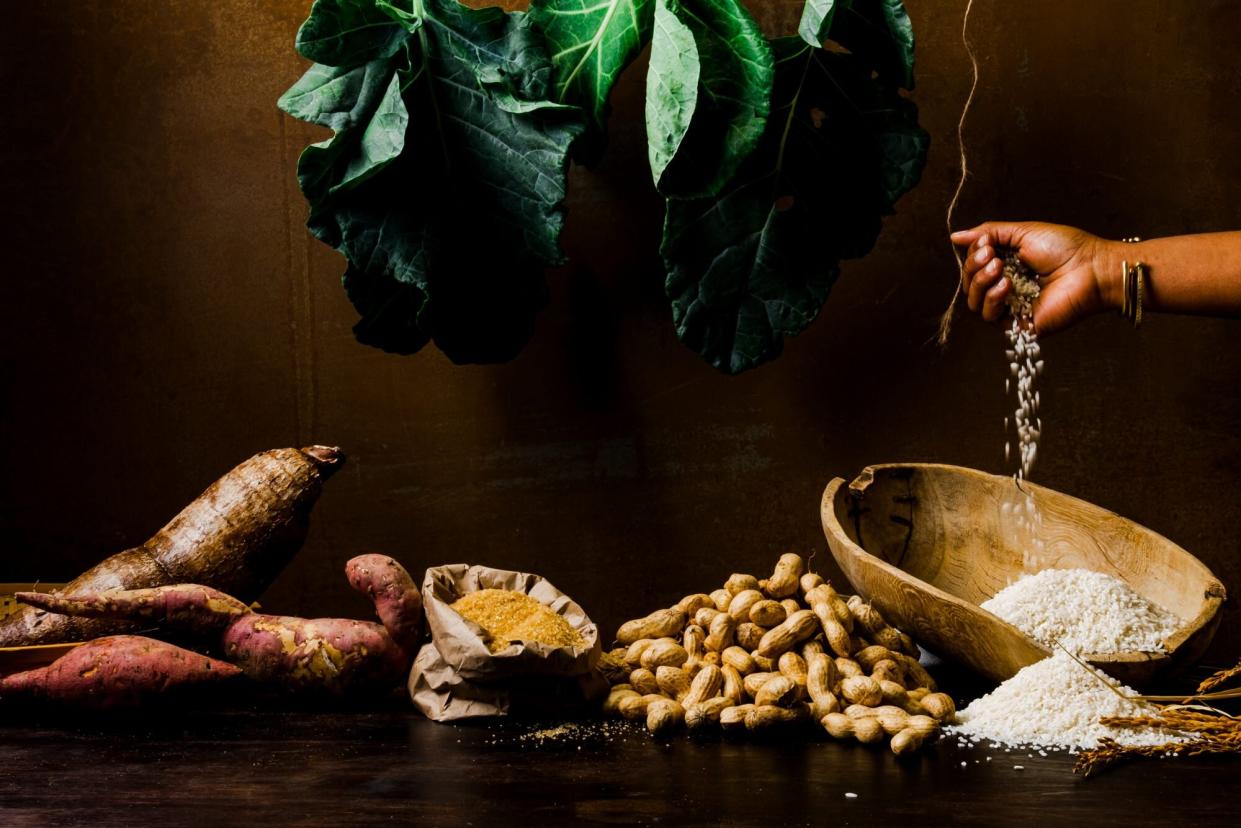
- Oops!Something went wrong.Please try again later.
Oriana Koren

Illustrations by Rachelle Baker
IN LATE AUGUST 1619, a year and a few days before the arrival of the Mayflower, around 20 Africans from the ship White Lion were sold in Jamestown colony; their arrival was duly recorded by John Rolfe (of Pocahontas fame), the colony's registrar. They were not the first Africans in what would become the United States, but they (and the hundreds of thousands of Africans who followed) brought with them, in their heads and hands, knowledge and skills that transformed the food of the nascent nation. Their position, and that of their descendants, at the bottom of the established pecking order placed them at the working epicenter of nation-building—and meant that, over the intervening four centuries, their influence in culinary life, agriculture, animal husbandry, brewing, and distilling would create a lasting culinary legacy that is often overlooked.
Establishing a chronology of labor is difficult, but the first work that was done was probably agricultural and domestic, with the newly arrived working in the fields alongside indentured whites. Angolan-born Antonio, one of the original group of Africans, served a term of indenture and became a farmer and a sizeable landowner. Through the work of Antonio and those like him, farming would be transformed by ideas, such as the careful planting of crops, that were a part of African and Native peoples' traditions. The crops produced from their methods yielded almost five times as much as the scattered-seed method that was common in Europe.
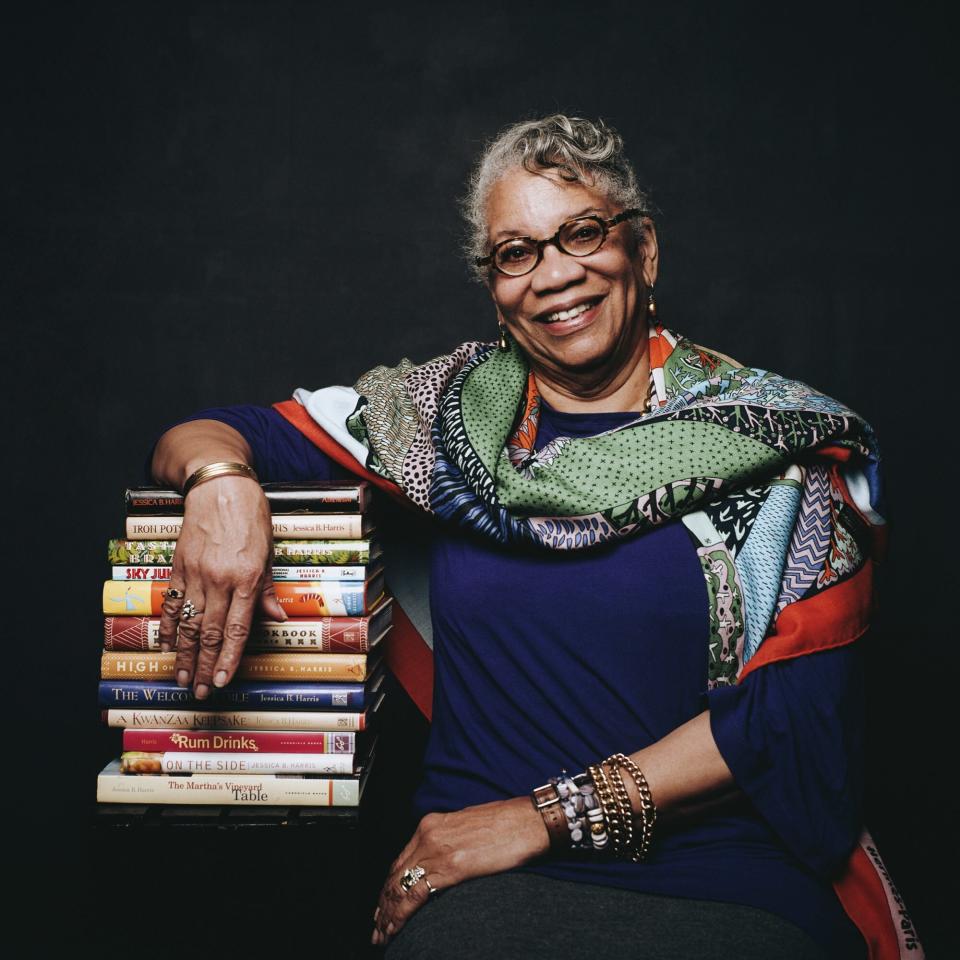
Rog Walker of Paper Monday
Agricultural practices from the African continent prevailed in many areas, but in none as much as in the cultivation of rice in the Carolina Low Country. From early years, the expertise of enslaved Africans who were from the rice-growing regions of West Africa—Senegambia, Liberia, and Sierra Leone—created extraordinary wealth for the Carolina colony. The Carolina Gold seed itself may have arrived from Madagascar. Other ideas ranging from crop rotation to systems of planting also were transmitted. Crops from Africa like okra, watermelon, black-eyed peas, sorghum, coffee, kola nuts, and sesame were brought across the Atlantic and became staples of the American diet, especially in the South. Some crops, like peanuts, arrived from other parts of the hemisphere via the African slave trade.
Recent studies suggest that not only plants but also animals may share African genesis. The celebrated Texas Longhorn cattle, long thought to be a mix of Criollo and European cattle, actually contain DNA of Fulani cattle from West Africa, and descendants of enslaved Fulani herdsmen were some of the nation's first cowboys. Indeed, by the end of the Civil War, fully 1 in 4 cowboys was Black.
Agriculture and animal management were not the only areas influenced by Africa and its descendants; the very taste of the new nation was given an African tinge by the myriad African American cooks who toiled in its taverns and kitchens. When many of the founding fathers sat to table, their meals were prepared by Black cooks and served by Black hands. Washington's chef, Hercules; Jefferson's chef, James Hemings; and unknown cooks for the signatories of the Declaration of Independence brought African American culinary know-how to the highest levels of the profession. In Star-Spangled Manners, Judith Martin, better known as Miss Manners, goes so far as to suggest that the very nature of America's much-vaunted Southern hospitality owes more to African customs than European ones.
The history of Black contributions to American cuisine is only now being fully told.
The scope of influence of African Americans in the beverage industry is still being uncovered, but already findings indicate that in the Colonial and Federal periods, a significant number worked in taverns as servers and were functioning as master brewers, as with Peter Hemings, James' brother, who occupied that position at Monticello. Nathan "Nearest" Green, who was born enslaved, was the distiller who taught his craft to Jack Daniel. As it was a branch of the service industry, many of the country's early bartenders were Black, and before Prohibition, most of the bartenders in Washington, D.C., were Black, even founding the Black Mixologists Club, a professional organization. Tom Bullock, who tended bar in St. Louis, wrote The Ideal Bartender in 1917, the first such tome penned by an African American—and one that became a bible for mixologists leading the craft cocktail revolution a century later.
Food also offered a range of possibilities for those with an entrepreneurial bent. Women in Gordonsville, Virginia, saw a market for selling food to passengers on the railroads that crossed the town: They sold fried chicken and baked goods through the train windows to hungry passengers. In 19th-century Philadelphia, Robert Bogle established a group of Black caterers who offered their services to the city's well-to-do. Around the country, African American street vendors hawked everything from New Orleans calas (rice fritters) to pig's feet in Harlem. African American eateries large and small have fed all Americans for centuries, from Providence's first ale and oyster house, opened by Emmanuel Bernoon in 1736, to Edouardo Jordan and Mashama Bailey's restaurants earning James Beard Awards today.
African Americans have toiled in every aspect of the country's food—growing it, selling it, serving it, and creating and offering the beverages to accompany it. It's a 400-year history that is only now in the 21st century being fully understood, researched, and told. It's about time. —Jessica B. Harris, professor emerita at Queens College, is a culinary historian, consultant, and cookbook author specializing in the food of Africa and its diaspora.
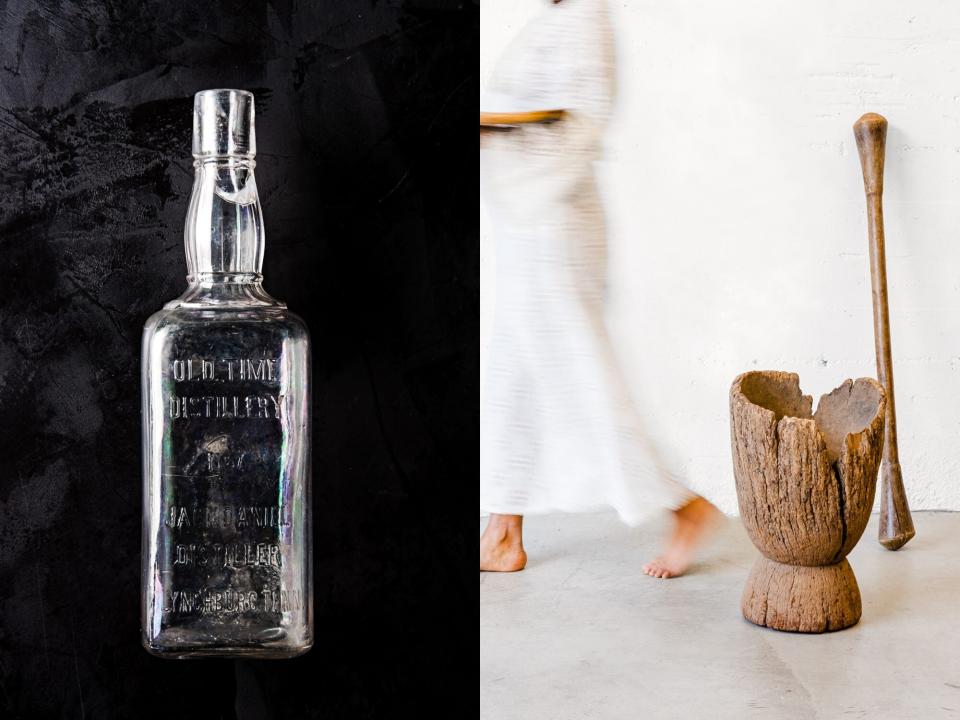
Oriana Koren
Top left: An early bottle of Jack Daniel's; the formerly enslaved Nathan "Nearest" Green was the first master distiller at Jack Daniel's and the first Black master distiller on record in the U.S. Top right: This sort of rice mortar and pestle would have been used by enslaved Africans to hull rice in a West African technique. Bottom left: Fanner baskets, used across the Low Country to winnow rice, are a technology brought to the U.S. from West Africa. Bottom right: This Victorian oyster fork is similar to what might have been used in Thomas Downing's luxurious Lower Manhattan oyster cellar. Many thanks to the Museum of Food and Drink in New York City, whose exhibit African/American: Making the Nation's Table opens April 3. For details, visit mofad.org.
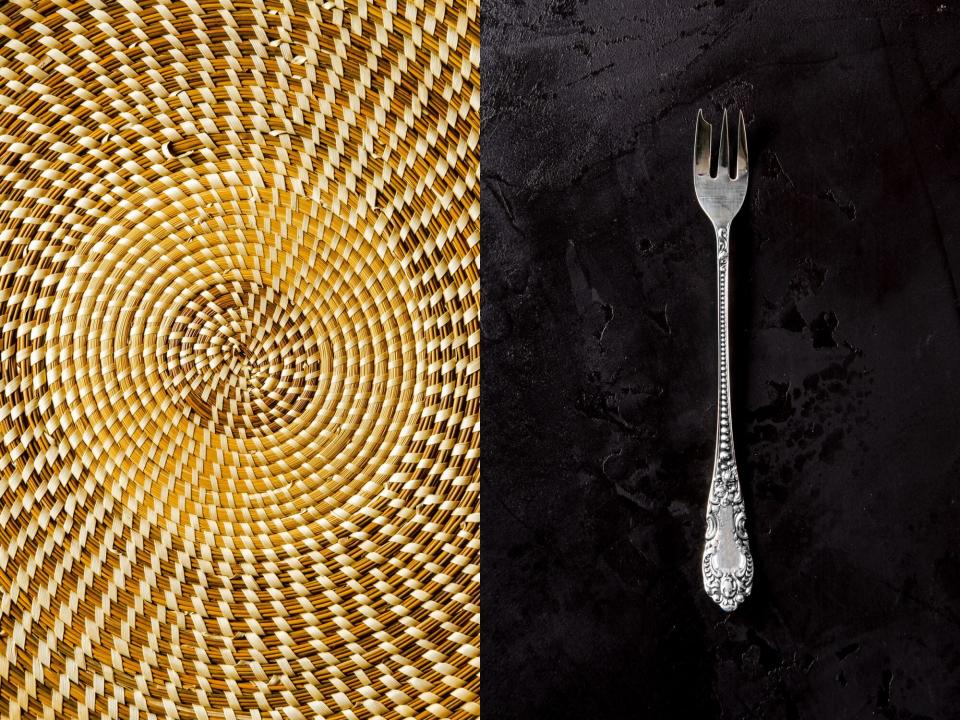
Oriana Koren

Illustrations by Rachelle Baker
A WARM VAT OF RICE sitting on the stovetop is a family's diagram of prosperity. Scorched-bottom silver pots chart out things you need to know about a brood. The engraved scratches are a remembrance of times of abundance and lack; a Tupperware canister front and center on the countertop is an allegorical sign of having more than you need.
Chef Joseph "JJ" Johnson's culinary journey took him from fine-dining kitchen brigades to dreaming up FieldTrip, his newest restaurant. His fast-casual rice bowl shop sits in the cradle of Black life—Harlem, USA—offering items like fragrant Carolina Gold rice with barbecue-tinged proteins. His late Puerto Rican maternal grandmother inspired his asopao, a comforting chicken and rice dish, and the only difference is that he cooks his grains before combining the spice and poultry. His grandma Iris' one-pot method turned out perfect, always.
East and west, north and south, the heart connects to the foot. From enslaved Africans cultivating in the Low Country in South Carolina and Georgia—the ancestors of today's Gullah Geechee people—to Johnson's eatery in Harlem, rice is a thread that connects generations of African American kitchens. When the Instant Pot hums or a chef's culinary voice sings, ancestors are honored. All is well when the electric cord stays plugged into the home. —Nicole A. Taylor is the executive food editor at Thrillist.

Illustrations by Rachelle Baker
AT THE ONSET of the 19th century in New York City, working in the oyster business was commonplace for many African Americans. In 1810, the New York City directory listed 27 oystermen; 16 were Black. When Thomas Downing showed up in 1819, he arrived with deep knowledge of regional fish and bivalves. His hustle muscle and business acumen were also very much intact.
Downing was also an abolitionist, caterer, and entrepreneur. Born to free Black parents and raised along the eastern shore of Virginia, he was adept in Atlantic waters. Less than 10 years after arriving in New York, he opened an oyster restaurant at 5 Broad Street in Manhattan. Like it is today, Broad Street was in a bustling financial district teeming with bankers, traders, and people of means. Unlike the more humble oyster cellars of the day, his space was adorned with a chandelier, fine carpet, and curtains, distinguishing Downing from not only his fellow Black oystermen but also the entire industry. In those days, oysters were so abundant that all you could eat could be had for just six cents. By 1842, oysters swelled to a $6 million industry catering to the elite, and Downing grew wealthy.
Respected by his financial and political clientele, Downing leveraged his social and monetary capital as an abolitionist. He harbored refugees from slavery in his cellars. For Downing, the oyster business, and more broadly the catering business, was about freedom. In 1836, he helped found the United Anti-Slavery Society of the City of New York and campaigned for equitable voting rights.
For today's Black chefs, Downing's legacy is living history. According to the U.S. Bureau of Labor Statistics, in 2018, 17% of chefs and head cooks were Black, about five percentage points higher than their representation in the entire workforce. Between 2007 and 2012, the number of Black-owned eating and drinking establishments increased by nearly 50%, according to the National Restaurant Association.
Though these numbers suggest broader participation in culinary arts among Black chefs, these chefs are part of a long lineage of independent culinary professionals who've taken what was once considered undesirable work and transformed it into a means of income and influence. Though industrialization and the Great Migration of the 20th century took many African Americans out of the kitchen, they are now returning to the industry. Chefs like Ashleigh Shanti, BJ Dennis, and Edouardo Jordan are bringing their full selves and history into their work. Their talents continue to unfold, each beautiful morsel a full-flavored reclamation of a centuries-old story. —Stephen Satterfield is an editor and cofounder of Whetstone Magazine.
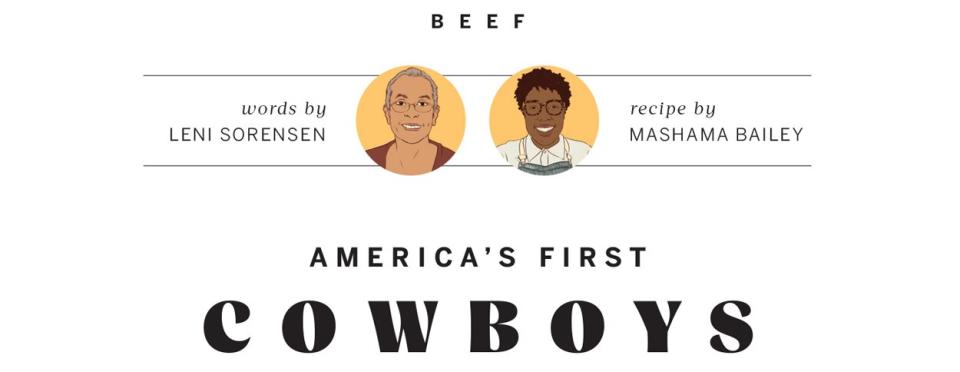
Illustrations by Rachelle Baker
IN COLONIAL AMERICA, beef cows were herded by enslaved men, many of whom had been born in cattle-raising areas of West Africa. They brought with them skills inherited from several thousand years of cattle-raising. In the Carolinas, they were known as cow hunters. These men rounded up the animals to secure in the cow pens at night, managed the herd, and butchered stock to be sold. Then as now, beef was an important commodity: Beef, salted in casks, was a significant part of trade to Caribbean sugar plantations, while cattle on the hoof were regularly herded to markets in urban centers.
Before the Civil War, cattle ranching moved ever westward into Texas and New Mexico, and after the war, 25% of American cowboys were Black men. That's 1 in 4 cowboys—men like Nat Love, Bass Reeves, and Bill Pickett—driving cattle on the two- to three-month journey along the Shawnee Trail, the Chisholm Trail, and the Goodnight-Loving Trail, bringing beef to northern shipping points in Kansas and beyond.
Black cooks also prepared and served beef, laying the foundations of American cuisine. All along the mid-Atlantic by the late 18th century, skilled plantation cooks had adapted English styles of beef cookery to the tastes of the dining elite. The 1824 cookbook The Virginia House-Wife listed no fewer than 18 beef recipes enslaved cooks were skilled at producing. Today, at The Grey in Savannah, Georgia, chef Mashama Bailey articulates this layered legacy in her braised beef shank recipe, flavored with peanut butter and coffee. —Leni Sorensen is a scholar and culinary historian in Crozet, Virginia.

Illustrations by Rachelle Baker
TO MARK THE SHIFT CHANGE between meal services at Benne on Eagle in Asheville, North Carolina, chef de cuisine Ashleigh Shanti leads her team in a focused but relaxed round of ingredient prep. Sometimes they pick crabmeat. Other times, they snap green beans. But often, usually, they strip collards. "We all do it together," she says of the time they carve out to mentally reset for the evening ahead. It's part of Shanti's appreciation for tedious but crucial labor: "It reminds me of my aunt [and] my grandmother, just doing that one thing together." With collards, it's not just how you stew, sauté, or season them that matters. The essence of the dish comes forth in its making.
At Benne, the year-old restaurant celebrated for its deferential yet creative approach to telling a Black Appalachian food story, collard greens play sideman—but never second fiddle. They appear in Shanti's collard green and shaved fennel salad, a raw application that Shanti says goes overlooked too regularly. They are traditionally stewed and served in their potlikker. Shanti often dries the leaves like "hanging britches" on a clothesline, taking a cue from her grandmother, who gave garlic and dragon beans the same treatment. She rehydrates them with buttermilk, cooks them down, and calls the side Buttermilk Britches in homage. Other uses of the brittle iteration get ground to a powder as part of the restaurant's house seasoning blend with benne seed, mushroom powder, kitchen pepper, Maldon salt, and brown sugar.
African American culture has historically been obscured from how this region is presented, but its influence has been tangible for centuries. On the dining room wall, four prominent portraits of African American women hold court. They are Hanan Shabazz, Mary Jo Johnson, Earlene McQueen, and Mary Frances Hutchinson, all restaurateurs from decades past who fed the historic Black neighborhood The Block, where Benne on Eagle makes its home today. "Collards have shown up on all their menus at some point," Shanti says of the women whose faces she can see from the open kitchen. "Collards are a dish that everyone in the community loved and can still relate to." —Osayi Endolyn is a James Beard Award–winning writer living in Gainesville, Florida.

Illustrations by Rachelle Baker
THE HISTORY OF ARACHIS HYPOGAEA, the peanut, originally domesticated in South America, became extremely Black almost immediately upon its introduction to West and Central Africa in the 1500s, during the early period of the transatlantic slave trade. The peanut was kissing cousin to the Bamana groundnut, a native edible that also produced shelled legumes in the ground. More prolific and versatile, used for everything from savory sauces to confections, the peanut spread and became a staple and, in time, crossed to North America on a reverse trip.
Called goobers or gooba peas by some, pindars by others, colloquial names for the peanut in the early American South had an Angolan connection, pointing to a fairly early introduction. Many enslaved Africans grew them in their provision gardens. In time the crop would know crossover appeal; by the 1830s and '40s, there were peanut plantations exporting the snack to the urban North, and by the Civil War, soldiers were singing, "Goodness, how delicious, eating goober peas." Boiled and roasted peanuts, peanut candy, peanut soup, and many other delicacies would join numerous confections, pies, cakes, and ice cream flavors laden with the peanut. And although he was not the inventor of the ancient preparation of peanut butter as many have thought, nobody popularized the peanut and its 300-plus uses more than Dr. George Washington Carver. —Michael W. Twitty is a food writer, historical interpreter, and culinary historian.

Illustrations by Rachelle Baker
"EXPECT NOT GOATS AND COWRIES, for my yams are dry, and the barns are empty," wrote Kukogho Iruesiri Samson, a Nigerian poet. Yams are considered to be the most common African staple aboard Middle Passage ships; some estimates say 100,000 yams fed 500 slaves, sometimes their only foodstuff.
Contrary to some folks' conception of holiday pies and marshmallow-studded mash, New World sweet potatoes feature in those dishes, not yams, which are eaten in West Africa, the Caribbean, throughout Latin America, and in parts of Asia and are a different vegetable entirely. Sweet potatoes tend to be long and pointed, with orange flesh, and are fairly sweet, while yams have whitish flesh and are larger and more cylindrical. Sweet potatoes are creamier, yams floury, starchier. In either case, they can be boiled, mashed, fried, or roasted over embers. Yams are honored in West African and Brazilian ceremonies and offerings to the orixás, in song, and in literature. Okonkwo, Chinua Achebe's tragic hero in Things Fall Apart, reveled in planting yams, deeming them the king of crops and thereby solidifying his manhood and ability to provide. In the New World, enslaved Africans found the sweet potato, which took its place. Ralph Ellison's Invisible Man celebrated a Harlem sweet potato vendor's steaming sugary pulp as nectar. He apologized for his ebullience and Carolina homesickness with every bite.
As the sweet potato takes up the role of the yam—foodstuff for sacred twins and ancestors—it epitomizes the adaptive creativity of the diaspora, a transfer food for Houston chef Jonny Rhodes to embrace in his Sweet Potato Gnocchi at his storytelling restaurant, Indigo. —Scott Alves Barton, PhD, is a chef and culinary educator.
Read more: The Difference Between Yams and Sweet Potatoes Is Structural Racism

Illustration by Rachelle Baker
Sugarcane, the bamboo-like grass that yields what one of Alexander the Great's commanders called honey from a reed, was brought to the Americas by Columbus in 1493. It flourished in the new hemisphere and transformed the agriculture, adding a diabolical twist to the production of sugar: the refinement of a plantation system in which huge tracts of land were worked by enslaved Africans. This system produced massive amounts of the white gold that fed Europe's insatiable hunger for sugar to sweeten the coffee and tea that were all the rage.
Sugar came late into the United States: The first cane was planted in Louisiana in 1751, and by 1795, Étienne de Boré had produced the first granulated sugar crystals. In 1843, Norbert Rillieux, a free man of color, patented the multiple-effect evaporator that offered a safer, cleaner, and cheaper way of producing sugar than the traditional Caribbean methods. Its adoption was rapid, and by the middle of the 19th century, Louisiana had become a hub of Queen Sugar, producing a quarter of the world's crop. Work in the cane fields was brutal and produced conditions that were even more harrowing than those cultivating rice, tobacco, indigo, or cotton. The history's not always sweet, but there's a lot of it in that small packet that comes with your morning coffee or tea. Think about that while sampling a piece of my mother's lemon pie. —Jessica B. Harris

